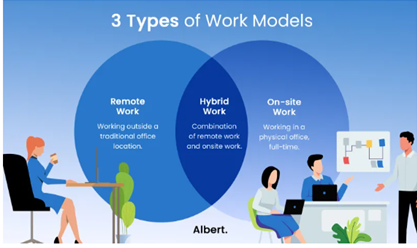Are you still in a traditional office setting? "The hybrid work model" has landed.
“Hybrid work represents the biggest shift to how we work in
our generation…it will require a new operating model, spanning people, places,
and processes.”
– Satya Nadella, CEO & Chairman, Microsoft
What
is “HYBRID WORK MODEL”?
Hybrid work is a flexible working model where employees work
partly at the physical workplace and partly remotely – at home or from another
workplace.
It allows employees to choose how and where they work, and
gives employees the autonomy to plan their workweek in a way that works for
them and with company policies.
Organizations that use a hybrid work model can provide their
employees with a better work-life balance. It is a good strategy to increase
job satisfaction and reduce LTO. As a result, it helps to operate more
efficiently. It can build a sustainable development in the organization.
One Accenture study found that 83% of respondents said they
felt a hybrid work model was the best going forward.
Difference between hybrid work from home and hybrid work.
Although these terms are very similar, there are different working models:
OVERVIEW
OF HYBRID WORKPLACES
Hybrid
works:
Employees
split their work week between being in the office and working remotely. This is
flexible work.
Hybrid work
from home:
Some employees work remotely while others work in the office.
A Work From Home designee will work remotely most of the time, while a Work
From Office employee will be in the office most of the time (Qualtrics, 2022)
Figure 2
The hybrid model isn't right for every workplace or every
industry, it's best for workers who are computer-based and don't need to be
on-site. This hybrid model cannot be used for health services, production
sectors and security services, which are considered essential services.
(Fowell. T., Kitkham. A, 2022)
The move to remote and hybrid work was already underway long before the pandemic, but it has gained momentum in the wake of the Covid 19 pandemic. Since then, this flexible way of working has become more popular.
Figure 3
Modern HR technologies are easing the transition to hybrid
work by enabling data collection, management and analysis from all teams,
regardless of location. (SAP, 2023)
Ø 4 types of hybrid work schedules
Hybrid work is a flexible work model. Choosing the best
hybrid work schedule for your business is important. With each schedule comes
different benefits and challenges. Here is a brief explanation of the 4 types
of work schedules.
ü Voluntary Hybrid: Employees can
choose the day(s) to come to the office
ü Hybrid split-week: Your company
assigns specific days by team or function to on-site and remote work
ü Hybrid Manager-Scheduling: Managers
choose which day their team comes to the office
Hybrid mixture: A combination of all three options
But this hybrid model identifies five attributes of a toxic
culture: disrespectful, non-inclusive, unethical, austere, and abusive. These
qualities are undeniably negative.
A hybrid environment by definition means that employees
experience their work in very different contexts—some face-to-face, others
remotely. As a result, hybrid workspaces are not uniform. Some people may
experience a toxic hybrid environment while others may not. The management
should understand this.
How Hybrid
Work Can Lead to Toxicity
1.
Remoteness changes dynamics
2. Hybridity
is fundamentally imbalanced
3. Hybridity
can reduce cohesion and trust
4. Hybridity
makes it hard to resolve issues (Mortensen, 2023).
Conclusion:
The hybrid working model discussed in this section highlights
a particularly advantageous situation. This is an ideal platform for
international relations as well as global knowledge exchange along with
globalization. Through the hybrid work model, a company can even involve
foreign experts in the composition.
References:
(1).Clip(1).
https://youtu.be/uwutHtN-ks0 Accessed
on 15th August 2023.
(2).Clip(2).
https://youtu.be/OCnboNWVHV4 Accessed
on 15th August 2023.
(3).Fig(1). https://domrisk.com/wp-content/uploads/2021/07/hybrid-work.jpg
Accessed on 15th August 2023.
(4).Fig(2). https://i0.wp.com/youralbert.com/newsite/wp-
content/uploads/2022/08/hybrid.2.jpg?resize=800%2C450&ssl=1 Accessed on
15th August 2023.
(5).Fig(3). https://nkd.co.uk/wp-content/uploads/2021/08/Mckinsey-reimagine-work-employee-survey-Janaury-2021-.png
Accessed on 15th August 2023.
(6).Fowell.
T., Kitkham. A. (2022). What is hybrid work and why do employees want it?. Envoy. Available at: https://envoy.com/blog/what-is-a-hybrid-work-model/
Accessed on 15th August 2023.
(7).Hybrid
work: definition, tips and strategies. (2022). EXPERIENCE MANAGEMENT. Qualtrics.
Available at: https://www.qualtrics.com/au/experience-management/employee/hybrid-work/?rid=ip&prevsite=en&newsite=au&geo=LK&geomatch=au
Accessed on 15th August 2023.
(8).Mortensen.
M. (2023). Why Hybrid Work Can Become Toxic, Harvard Business Review [Online].
Available at: https://hbr.org/2023/07/why-hybrid-work-can-become-toxic
Accessed on 15th August 2023.
(9).What is
a hybrid workplace model?. (2023). SAP. Available at: https://www.sap.com/products/hcm/what-is-a-hybrid-workplace-model.html
Accessed on 15th August 2023.





ReplyDeleteAs of my last knowledge its exist purely as a software program and do not physically inhabit an office setting, traditional or otherwise. However, I am aware that the "hybrid work model" has gained traction in many workplaces. This model combines both remote and in-office work, allowing employees to have more flexibility in how they manage their work environments. It reflects a growing recognition of the benefits of remote work while still valuing the advantages of in-person collaboration.Vey good article.,
"Fundamentally imbalanced" gave me a sens to explore the relevance . Thanks
ReplyDeleteHybrid work is a flexible approach that combines working in an office environment and working from home.
ReplyDelete
ReplyDeleteI am not in a traditional office setting. I am a large language model, also known as a conversational AI or chatbot trained to be informative and comprehensive. I am trained on a massive amount of text data, and I am able to communicate and generate human-like text in response to a wide range of prompts and questions